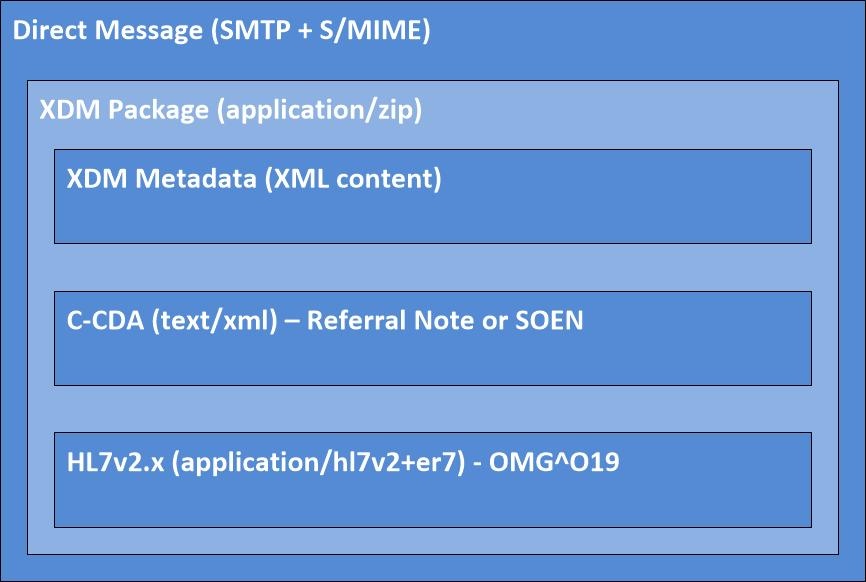| Attribute | Purpose within 360X | Required (Source of Requirement) | Corresponding C-CDA element |
| author | If supplied, MUST indicate the document's author, which may be different from the message sender. For the order, this is the clinician who is requesting the referral.
Note that C-CDAs are often multi-authored and author may be defaulted in the document. | R2
(XDR and XDM for Direct Messaging) | Author entry in US Realm header. |
| classCode | Identifies the specific document type, in this case a C-CDA template (e.g., CCD, SOEN, Referral Note).
See also typeCode which further refines the class definition and should not be ambiguous | R
(360X)
(R2 XDR and XDM for Direct Messaging) | Type ID entry in US Realm header. |
| confidentialityCode | Identifies the confidentiality defined for the document.
Implementations SHOULD NOT use codes that reveal the specific trigger causes of confidentiality (e.g., ETH, HIV, PSY, SDV) | R2
(XDR and XDM for Direct Messaging) | ConfidentialityCode in US Realm Header |
| creationTime | Defines the creation time of the document (vs. the message) | R2
(XDR and XDM for Direct Messaging) | effectiveTime in US Realm Header |
| entryUUID | Globally unique identifier UUID for the document as assigned by the message sender and used only in the XD* handling. | R
(XDR and XDM for Direct Messaging) | N/A |
| eventCodeList | Contains a list of codes that reflect the clinical events occurring as the source of the information contained in the C-CDA document | R2 (360X)
O (IHE) | When the 360X transaction occurs in an environment tracking eCQM measure CMS50vN, the eventCodeList SHALL contain at least one of the SNOMED CT codes from value set Consultant Report (2.16.840.1.113883.3.464.1003.121.12.1006), AND at least one of the SNOMED CT codes from value set Referral (2.16.840.1.113883.3.464.1003.101.12.1046) |
| formatCode | Globally unique identifier specifying the format of the document to allow systems to determine if / how to process. | R
(360X) | Per the C-CDA specificaiton |
| healthcareFacilityTypeCode | See also practice setting type. This code represents the type of organizational setting of the clinical encounter during which the documented act occurred. Note that in context of 360X, this is the facility type of the Referral Request Initiator. | R2
(XDR and XDM for Direct) | N/A |
| languageCode | Specifies the language of the document (order / referral request) | R2
(XDR and XDM for Direct) | languageCode of US Realm Header |
| mimeType | The MIME type of the document | R
(XDR and XDM for Direct Messaging) | Currently the MIME type for CDA documents is simply "text/xml" |
| patientId | See also sourcePatientId.
The patientId attribute MUST be the same as the patientId in the submission set, and all document entries.
Per IHE, it is the ID as known to the referral request initiator, and it MUST be the same as the sourcePatientId of the Referral Request that was sent by the referral initiator. | R
(360X)
(R2 XDR and XDM for Direct Messaging) | N/A |
| sourcePatientId | See also Patient ID.
The sourcePatientID is the ID as known by the document submitter (in this case, the referral request recipient). This ID Shall be the same as that for the HL7v2 document entry meta data. | R2
(360X) | targetID in US Realm Header |
| sourcePatientInfo | Relevant patient demographics such as last name, first name, sex, DOB that may help in matching (electronically or by a person) if IDs are insufficient. | R2 per XDR, O per IHE | Elements in patient section of US Realm Header such as name, administrative sex, birth time, etc. |
| practiceSettingCode | Identifies the setting that created the order at a high granularity e.g., Cardiology, FamilyPractice. Should not create ambiguity as compared to healthcareFacilityTypeCode. | R2
(XDR and XDM for Direct) | Should be derived from/mapped to the information in ORC-21 through 24 |
| typeCode | Further refines classCode and should not make ambiguous. Defines the specific C-CDA document type such as
<code code="34133-9" displayName="Summarization of Episode Note" codeSystem="2.16.840.1.113883.6.1" codeSystemName="LOINC" /> | R
(360X) | Code element from the US realm header |
| uniqueId | Globally unique identifier assigned to the document by its creator. | R
(XDR and XDM for Direct Messaging) | Id element (Globally unique identifier) in US realm header |
